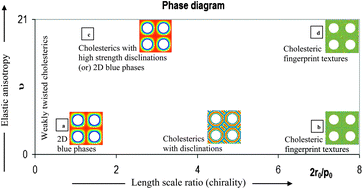A systematic, computational and scaling analysis of defect textures in polygonal arrangement of cylindrical particles embedded in a cholesteric (Ch) liquid crystal matrix is performed using the Landau–de Gennes model for chiral self-assembly, with strong anchoring at the particles' surface. The defect textures and LC phases observed are investigated as a function of chirality, elastic anisotropy (monomeric and polymeric mesogens), and polygonal arrangement and size of particles. The presence of a polygonal network made of N circular inclusions results in defect textures of a net charge of −(N − 2)/2 per unit polygonal cell, in accordance with Zimmer's rule. As the chirality increases, the LC matrix shows the following transition sequence: weakly twisted cholesterics, 2D blue phases with non-singular/singular defect lattices, cholesteric phases with only disclinations, and finally fingerprint cholesteric textures with disclinations and dislocations. For monomeric mesogens at concentrations far from the I–Ch phase transition and low chirality, for a given symmetry of the LC phase, the particle with weaker (stronger) confinement results in a phase with lower (higher) elastic energy, while at high chirality the elastic energy of the LC phase is proportional to the number of particles that form the polygonal network. Thus, hexagonal (triangular) particle arrangement results in low elastic energy at low (high) chirality. For semiflexible polymeric mesogens (high elastic anisotropy), defect textures with fewer disclinations/dislocations arise but due to lamellar distortions we find a higher elastic energy than monomeric mesogens. The defects arising in the simulations and the texture rules established are in agreement with experimental observations in cellulosic liquid crystal analogues such as plant cell walls and helical biological polymeric mesophases made of DNA, PBLG and xanthan. A semi-quantitative phase diagram that shows different LC phases and defect textures as a function of chirality and elastic anisotropy is obtained. The inclusion of particles has a stabilizing effect on the LC phases, as they occupy λ+1 disclination cores, thereby reducing the free energy cost associated with these disclinations. These findings provide a comprehensive set of trends and mechanisms that contribute to the evolving understanding of biological plywoods and serve as a platform for future biomimetic applications.


 Please wait while we load your content...
Please wait while we load your content...